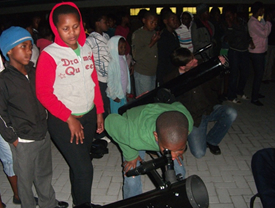| 50% of you think that the South African Government has the potential to make the biggest impact on reducing carbon emissions in South Africa; | |
| 8% opted for the technology sector; and | |
| 42% opted for private industry. |
Shuttle Discovery landed for the last time at Florida’s Kennedy Space Centre on 9 March 2011. Discovery has completed 39 space voyages (its first being on 30 August 1984), has spent a total of 365 days in space and travelled more than 238 million kilometres during it’s lifetime.

 |
Learners and parents look at |
Spending the evening being amazed by our night sky’s beauty sparks much excitement and many questions about space and what all is out there.
“If people cannot come to us to observe the night sky, we will take our telescopes to them.” This is exactly what the education and outreach department of the South African Astronomical Observatory (SAAO) decided to do after they noticed that very few schools actually make use of the opportunity to visit the Observatory on designated open nights for schools, and that very few people from the nearby areas of Gugulethu and Mitchell’s Plain attend these regular open nights.
“This is probably not only due to a lack of interest in astronomy but also a lack of transport in the evenings, and safety concerns,” says Sivuyile Manxoyi, SAAO, who is project coordinator. Telescopes in Education and Schools (TIES) was conceptualised to overcome these obstacles. The project seeks to enrich natural science teaching through practical observation of the stars and also using astronomy to inspire the youth about the vastness and beauty of our universe. There has also been an unexpected but most welcome interest from parents who want to participate in the project.
The SAAO team visits schools on Thursdays nights, weather permitting. “It is always great to see the excitement on the faces of people who observe spectacular planets like Saturn and Venus. The curiosity generated is wonderful and they start asking questions such as ‘Why does it appear like the moon?’, ‘Is it the moon?’, ‘Why can’t we see the rings when looking with just our eyes?’, ‘Why are there so many stars when looking through the telescope but I only see one with the naked eye?’. Science engagement at its best!” says Manxoyi. “I believe the sky is not the limit but just another playground for both adults and youth. Through astronomy we can inspire all our people.”
As part of the project the SAAO will visit the schools that won the SAASTA AstroQuiz, at provincial level. Other schools that have already been visited are Vuyani and Siyabulela Primary Schools, and St Mary’s and Langa High schools. “This is all made possible through the assistance of the astronomy postgraduate and postdoc students who willingly assist me with this project.”
If you are interested in starting a similar project, you are encouraged to contact Sivuyile Manxoyi on +27 21 447 0025 or +27 83 703 4817 or sivuyile@saao.ac.za.
